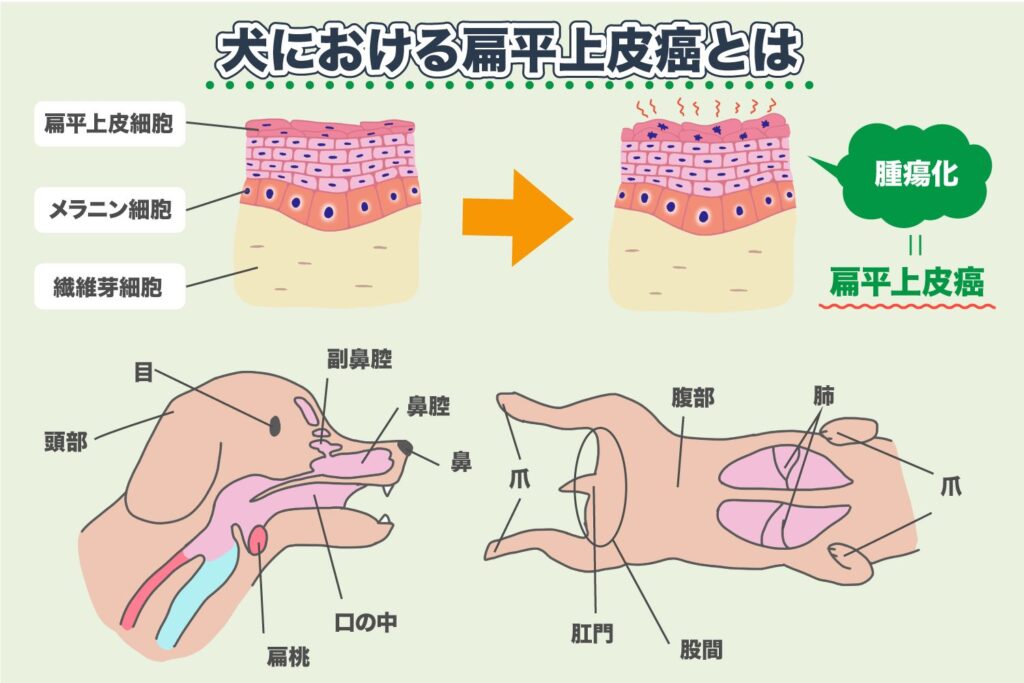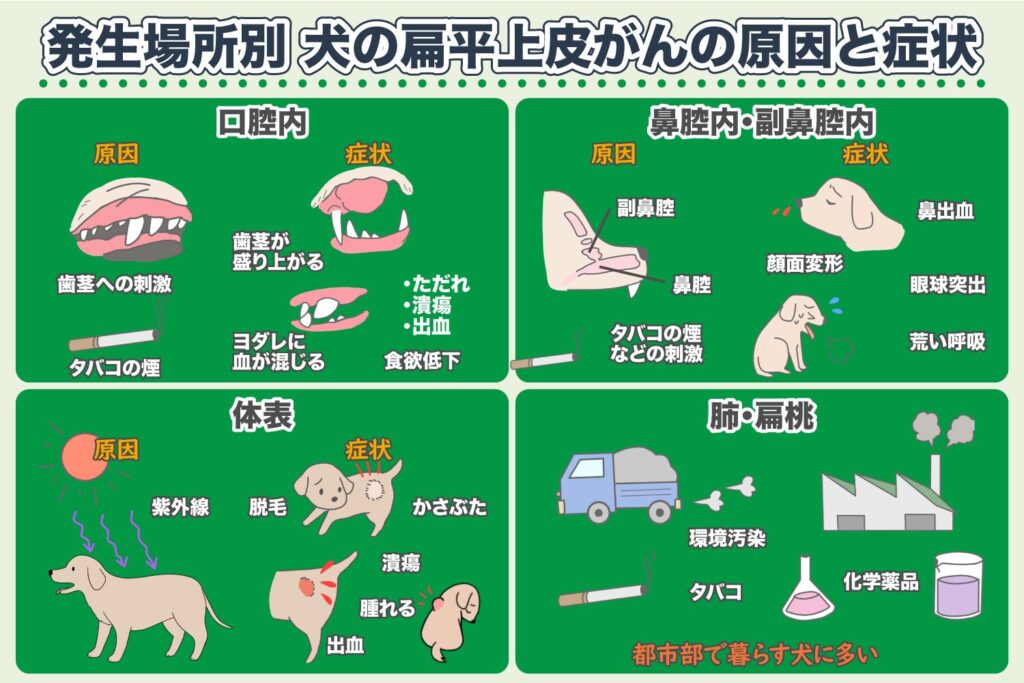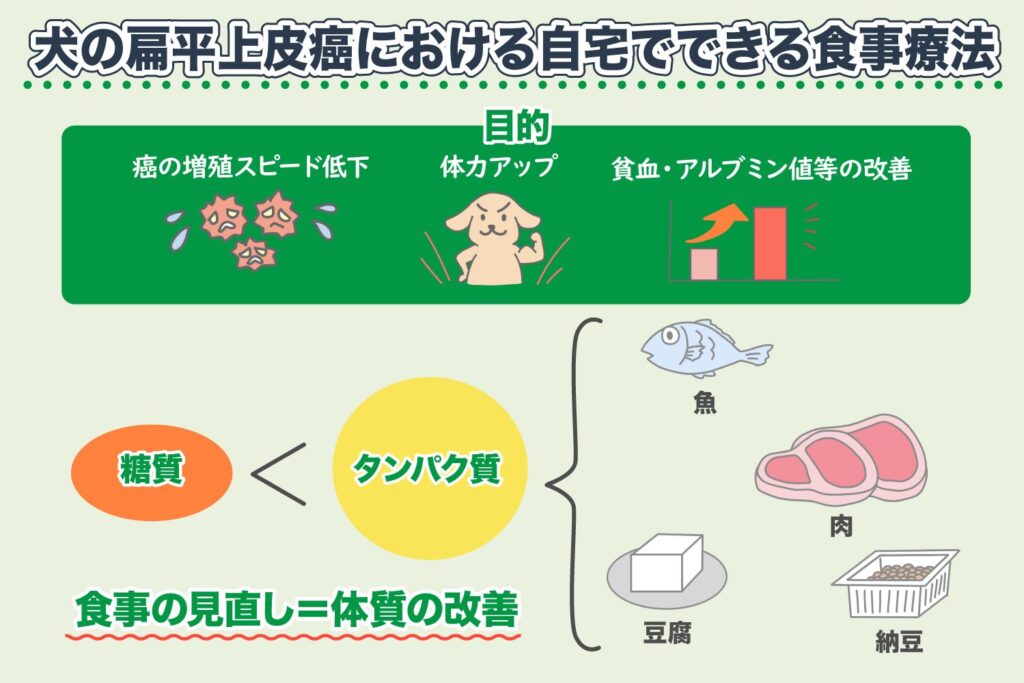Squamous cell carcinoma in dogs is a type of cancer that originates from squamous epithelial cells, which produce the skin and mucous membranes. This cancer can occur in various parts of the body and can metastasize. Although it’s a challenging disease, we believe that working on immunity can improve the dog’s condition, maintain their QOL (quality of life), and help them regain their energy and appetite. In fact, there have been numerous cases where controlling a dog’s cancer through immune strategies with Cordy has been successful.
This page summarizes the causes, symptoms, treatment methods, tips for improvement and cure of squamous cell carcinoma. Many examples of improvements are also introduced. We hope to provide support and be a beacon of hope for everyone.
目次
What is Squamous Cell Carcinoma in Dogs?

Squamous cell carcinoma refers to a tumor formed by the squamous epithelial cells that produce the skin and mucous membranes.
In dogs, it can occur in any location where squamous epithelial cells are present, such as the oral cavity, eyes, nose (nasal cavity, sinuses), head, tonsils, lungs, claws, groin, abdomen, and anus, making it a type of malignant tumor (cancer).
Other types of skin cancers include melanoma arising from melanocytes, fibrosarcoma from fibroblasts, cutaneous lymphoma, and mast cell tumors.
Causes and Symptoms of Squamous Cell Carcinoma in Dogs

Oral Squamous Cell Carcinoma in Dogs
One of the main causes of squamous cell carcinoma in the oral cavity is believed to be irritation to the gums.
Chronic irritation caused by hard dry food or treats can damage the gum tissue, leading to the cancerous transformation of cells, resulting in a raised gum area.
As the condition progresses, symptoms such as ulceration, sores, bleeding, blood-tinged drool, pain that makes eating difficult, and decreased appetite may occur.
Additionally, recent reports indicate that tobacco smoke increases the incidence of squamous cell carcinoma in dogs and cats.
(Tobacco smoke affects not only squamous cell carcinoma but all types of tumors. Therefore, households with smokers need to be cautious.)
Squamous Cell Carcinoma in the Nasal Cavity and Sinuses in Dogs
When squamous cell carcinoma occurs in the nasal cavity or sinuses, symptoms such as nosebleeds, facial deformations, bulging eyes (proptosis), and labored breathing (due to nasal congestion) may appear.
Daily irritation to the nasal cavity and sinuses is also a contributing factor. Caution is required if there are smokers in the household.
Squamous Cell Carcinoma on the Skin in Dogs
When squamous cell carcinoma develops on the skin, it is thought to be caused by ultraviolet-induced cellular damage.
The affected skin may exhibit hair loss, scabs, ulcers, and as the disease progresses, swelling, ulceration, and bleeding may occur. If the carcinoma develops on the ears, it can even lead to ear loss.
Squamous Cell Carcinoma in the Lungs and Tonsils in Dogs
Squamous cell carcinoma, which occurs in the lungs and tonsils, is said to be more common in dogs living in urban areas. This could potentially be due to environmental pollutants such as air pollution. Of course, exposure to tobacco and chemical substances also plays a significant role.
Incidentally, in humans, squamous cell carcinoma is commonly found in the oral cavity, nasal cavity, paranasal sinuses, pharynx (throat), esophagus, as well as the lungs and cervix (entrance of the uterus). Squamous cell carcinoma of the cervix is often attributed to chronic inflammation caused by the human papillomavirus (HPV). For other areas like the head and lungs, factors such as tobacco, strong alcohol, spicy foods, and hot foods are considered as triggers.
Moreover, elderly individuals and those with compromised immune systems are more susceptible to developing this condition.
Diagnosis and Common Treatment Methods for Canine Squamous Cell Carcinoma

Diagnosis involves histopathological examination of the tumor site (fine-needle aspiration, biopsy, partial resection, complete resection, etc.).
The fundamental treatment is surgical excision.
Since these tumors tend to spread to surrounding areas, a wide surgical margin is necessary, resulting in a larger wound. Postoperatively, radiation therapy and chemotherapy may also be utilized. In cases where surgery is not feasible, radiation and chemotherapy are employed.
Canine Squamous Cell Carcinoma Treatment Methods – Surgery
There are two types of surgery: curative surgery and palliative surgery.
Curative surgery aims to thoroughly prevent recurrence by removing the tumor along with a wide margin of surrounding tissue. However, it is important to note that this type of surgery represents a ‘possibility’ of cure, and it does not guarantee ‘complete cure’.
Palliative surgery, also known as relief surgery, is employed when extensive or complete excision is not possible. This method involves the partial removal of the tumor to temporarily resolve problems caused by the tumor and to maintain quality of life (QOL) to some extent.
Given that palliative surgery entails only partial removal of the tumor, it inherently leaves behind cancer cells, and therefore, complete cure cannot be achieved with surgery alone.
Canine Squamous Cell Carcinoma Treatment Methods – Chemotherapy
**Anticancer agents are now increasingly using molecular targeted drugs such as Imatinib and Toceranib.**
Molecular targeted drugs aim at molecules involved in cell proliferation, infiltration, and metastasis. Compared to traditional anticancer drugs, it is said that they have fewer side effects. However, since they still belong to the family of anticancer drugs, it is inevitable that they exert a burden on the body.
Additionally, while these drugs have shown effectiveness in treating canine mast cell tumors, their use for other tumors remains unclear. According to materials from the Japan Small Animal Cancer Center, Toceranib has shown relatively good treatment results in cases of canine squamous cell carcinoma.
### Treatment of Canine Squamous Cell Carcinoma-Radiation Therapy
Squamous cell carcinoma tends to respond relatively well to radiation therapy, so it is used in combination with surgery or as a standalone treatment. However, responses to radiation can vary among individuals, and since the treatment requires general anesthesia, the burden from the anesthetic cannot be ignored.
For older dogs or those with lung diseases, the risks associated with anesthesia increase, necessitating cautious decision-making.
### Points to Consider When Treating Squamous Cell Carcinoma
Both surgery, anticancer agents, and radiation therapy have their advantages and disadvantages.
The owners know their dog’s condition the best.
Don’t just accept treatment because a veterinarian recommended it, only to find that it worsens your dog’s condition or increases their suffering. It’s important for the owners to take the lead and decide whether to proceed with treatment, take a break, or not undergo treatment at all, for the sake of their beloved dog’s well-being.
## Alternative Therapies for Canine Squamous Cell Carcinoma
As the name suggests, alternative therapies are treatments that replace surgery, anticancer drugs, and radiation therapy. Many alternative therapies are less burdensome on the body, making it possible to combine several treatments simultaneously.
The low damage means that they are not highly limited by the stage or condition of the disease.
Pre-surgery, post-surgery recurrence prevention, cases where surgery is not possible, cases with lung metastasis, and even when the body is weakened, many alternative therapies can be performed.
Particularly in the following cases, considering alternative therapies can be very meaningful:
- When there are complications and general treatments carry high risks
- When aiming for coexistence with cancer
- When you want to prioritize avoiding a decrease in quality of life (QOL)
- Before a definitive diagnosis is made
- When the diagnostic result just doesn’t sit right
Things You Can Do at Home – Diet Therapy

Meals are an everyday occurrence, and it’s through these meals that the bodies of not only humans but also dogs and cats are built.
Revising the diet can lead to improvements in constitution.
To maintain a body that can uphold immune strength, first, reconsider the daily meals.
The aim of diet therapy is to slow the proliferation speed of cancer cells, build strength, and improve conditions such as anemia and albumin levels.
Our company, as well as some animal hospitals, place great emphasis on a nutritional approach as the foundation of treatment.
The primary energy source for cancer cells is carbohydrates. A diet therapy that restricts carbohydrates as much as possible can be started immediately without risk.
However, diet therapy cannot be carried out without the cooperation of all family members at home.
Please provide plenty of proteins such as fish, meat, tofu, and natto, and reduce the quantity of foods that are high in carbohydrates and sugars.
Merely changing the diet will not cure cancer, but by restricting carbohydrates, which are essential for the growth of squamous cell carcinoma, you can slow down the progression speed. Although it requires more time and effort compared to simply providing commercial food, I hope you can start without overthinking it.
Tips for Diet Therapy
To reduce the hassle for everyone involved, we have created a food list. Please take a look.
Even Pets Follow the Principle of “Food is Medicine”: Ingredients to Fight Cancer
Immune Support Measures Against Squamous Cell Carcinoma
When your beloved dog is suffering from squamous cell carcinoma, regardless of whether they undergo surgery, radiation therapy, or chemotherapy, it is very important to implement immune support measures.
At our laboratory, we continue to research whether administering Cordy helps in faster immune recovery when the immune system is weakened due to surgery or chemotherapy.
While we don’t know the extent of the response, at the very least, there is plenty of potential for appetite stimulation and energy recovery.
When using medications such as chemotherapy, steroids, or antibiotics, there is also concern about liver function decline.
In such cases, using domestically sourced SPF pig-derived placenta extract powder in conjunction might help minimize liver damage.
Even for those whose liver values have already worsened, there are not few cases where liver function improves within about a month of taking domestically sourced SPF pig-derived placenta extract powder.
At our laboratory, we continue our research on Cordy, which is expected to have immune-regulating effects, and domestically sourced SPF pig-derived placenta extract powder, which is expected to protect liver function. If you have any questions, please feel free to contact us.
監修獣医師:林美彩 所属クリニック:chicoどうぶつ診療所

代替療法と西洋医学、両方の動物病院での勤務経験と多数のコルディの臨床経験をもつ。 モノリス在籍時には、一般的な動物医療(西洋医学)だけでは対応が困難な症例に対して多くの相談を受け、免疫の大切さを痛烈に実感する。
ペットたちの健康維持・改善のためには薬に頼った対処療法だけではなく、「普段の生活環境や食事を見直し、自宅でさまざまなケアを取り入れることで免疫力を維持し、病気にならない体づくりを目指していくことが大切である」という考えを提唱し普及活動に従事している。
所属:
- An example of using Cordy for feline squamous cell carcinoma
- An improvement case of feline splenic cancer (lymphoma/ mast cell tumor)
- An example of using Cordy for canine mesenteric lymphomas (Miniature Dachshund)
- An example of using Cordy for high-grade abdominal lymphomas (Shih Tzu)
- An example of using Cordy for canine lymphoma (Yorkshire Terrier)
- A case where abdominal malignant lymphoma in a cat (one-month prognosis, with lung metastasis) disappeared
- A case of long-term maintenance in a cat suspected of having lymphoma
- Improvement Case of Spleen Cancer (Lymphoma/Mast Cell Tumor) in Cats
- Case of Controlling Lymphoma/Thymoma in Rabbits Without Burden
- Dog Melanoma – Causes, Symptoms, Treatment, Tips for Improvement and Cure
- Fibrosarcoma in Cats and Dogs – Malignant Tumors, Examination, Surgery, Treatment Methods, Tips for Improvement and Cure
- Cutaneous Lymphoma
- Mast Cell Tumor in Dogs – Causes, Symptoms, Examination Methods, Treatment Methods, Tips for Improvement and Cure
- Cancer (Tumor) in Dogs – Symptoms, Examination, Surgery, Treatment, Diet, Tips for Improvement and Cure






